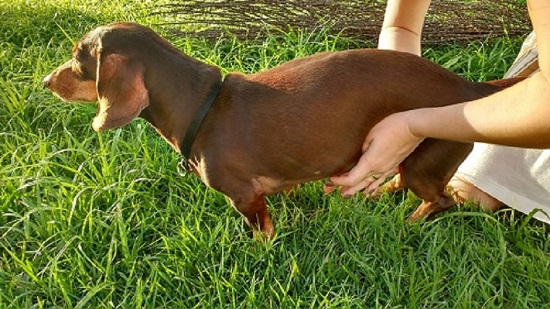
Table of Contents[Hide][Show]
Finding out that your dog has urinary incontinence can be a scary diagnosis. It means that your pet has lost the ability to control when and where they urinate, and as their guardian, it’s up to you to manage the condition with diapers or learning how to express your dog’s bladder.
Most pet parents have no problem diapering a dog, but they can’t imagine manually emptying the bladder. If your veterinarian thinks your pup is a good candidate, let me reassure you that you will be able to master the technique.
Manually expressing a dog is the best option to keep an incontinent dog healthy. It decreases the risk of urinary tract infections and urine scald. For some dogs, it’s critical to their health because expressing their bladder is the only way to empty urine.
The technique looks strange at first, but with a little practice most pet parents quickly become pros.
Note: Please talk with your vet about your dog’s medical condition before using the techniques in this post.
Why dogs become incontinent
Many conditions contribute to urinary incontinence. They include: old age, Cushing’s Disease, Diabetes and injuries.
The number one reason dogs become incontinent is paralysis. If your dog is paralyzed in their hind end, the likelihood of losing bladder control is almost guaranteed. The problem lies in the central nervous system, which houses the spine and coordinates communication to the bladder. Paralysis turns off the system.
The cause of a dog’s mobility problem also plays a big role in their incontinence. For instance, victims of Pug Myelopathy develop an “upper motor neuron bladder.” That means the muscles which release urine, are closed tight. Without manually expressing their bladders, these pups are in big trouble.
Their bladders retain urine and stretch to an unhealthy size, causing permanent damage and a breeding ground for bacteria to grow.
Expressing the bladders of these dogs isn’t a choice. It’s critical to their health.
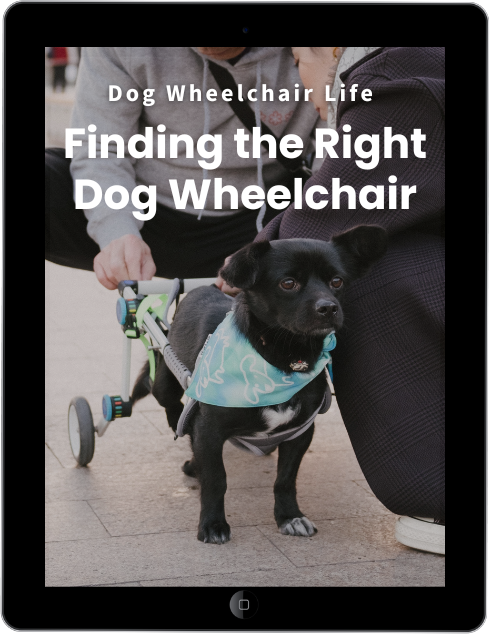
eBook
Find The Right Dog Wheelchair For Your Pet
Your dog has a mobility problem, and you want to buy a wheelchair. But do you know what kind of cart will work best for your dog’s individual needs? After a decade of teaching pet owners how to make the right choice, I put the information into an eBook!
How to find a dog’s bladder

The first part of learning how to express your dog begins with finding your pet’s bladder. It can be a bit tricky. Of course, you know the bladder is located by your dog’s belly, underneath the hind legs, but it shifts slightly as it fills. To find the bladder of a male dog, place your hands above the middle of the penis. The bladder of a female dog is located further back, above a dog’s hind legs.
My vet told me to feel for a furry tennis ball in the lower belly of my dog Sophie. It painted a clear picture in my mind of what I was supposed to look for, but that’s not exactly the shape most people find. The bladder is more oval than ball shaped and has the consistency of a balloon vs. a tennis ball. It also grows larger as urine accumulates so the size of the balloon varies.
The bladder is generally about the size of a lemon for small dogs and can be as big as a grapefruit for big dogs.
You’ll find the bladder between the rib and hip of a small dog and closer to the hips of a large dog.
If you have problems locating the bladder, enlist the help of your vet. A hands-on lesson can be extremely helpful.
Choose your bathroom spot
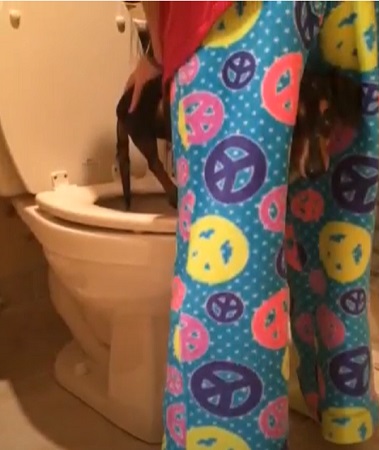
Every pet owner and dog need to work out the best location for expressing. The perfect spot for Sophie and me was on the lawn in our backyard. It was the same spot Sophie “did her business” before she was paralyzed so she didn’t have anxiety about being expressed there.
Here are other bathroom sites pet parents use:
Lying the dog on their side over a pee pad in a quiet room
Expressing in the shower or tub
Holding the dog upright, over a waterproof blanket
Raising your pup to a level that’s comfortable for you, like on a table or sofa.
Expressing over the toilet
Wherever you choose, make sure there are plenty of baby wipes to clean your dog’s belly afterward. Urine that’s left on sensitive skin can cause burns and scalding.
Keep the potty location you choose. It’ll go a long way fostering trust between you and your pup and alleviating fears your dog has about the procedure. Remember, expressing your dog’s bladder is a new experience for your pet too.
Here’s one final tip a pet parent told me, “Always praise your dog after expressing them. They need to know you’re proud of their effort.”
Create a bathroom schedule
It’s important to create and stick to a strict bathroom schedule. Your dog will appreciate the routine and it’ll prevent the bladder from stretching and retaining urine. Incontinent dogs are prone to recurring urinary tract infections. A solid bladder expressing schedule will keep this to a minimum.
Most dogs need to be manually expressed 3-4 times a day or 4-6 times a day for small breeds. To give you an idea of a bathroom schedule, here’s what Sophie’s looked like:
Morning – As soon as she woke up, I took her to the lawn to be expressed.
Afternoon – Another potty break was scheduled for early afternoon.
Dinner – I took her outside about 30 minutes after her dinner.
Bedtime – Sophie’s bladder was expressed one final time before she went to sleep.
“Express your dog before feeding. It’s easier to locate the bladder and it reduces the risk of your dog vomiting after your pet has eaten.”
Jill Murray, RVT
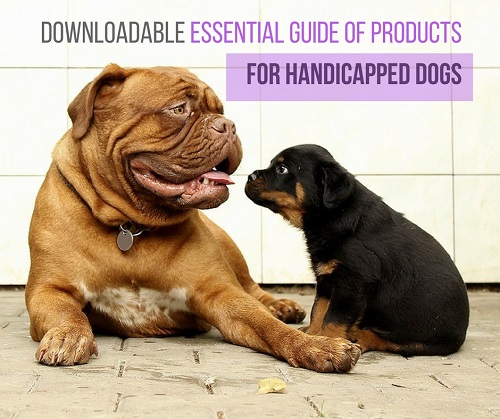
Get the Essential Guide
The Essential Guide of Products for Handicapped Dogs e-book is a labor of love for me. I wrote it to answer your most pressing questions about where to find the best products for your wheelchair dog. You’ll find products you didn’t know existed and each will improve your dog’s quality of life. Print a copy and keep it by your side.
How to express your dog’s bladder

The two-handed method:
Start by placing your dog in the position where they are most comfortable for expressing. That can be in a standing or lying down position.
Place your hands on each side of the bladder.
Push slow and steady on the bladder by bringing your hands together until you get a stream of urine.
Continue to push until the stream becomes a trickle or stops.
Release your hands for 30 seconds. Then try again. This will get the remaining urine out of bladder. The goal is to completely empty your dog’s bladder.
Clean the skin around the lower belly with baby wipes and a fluffy soft towel.
Over the arm or sling method:
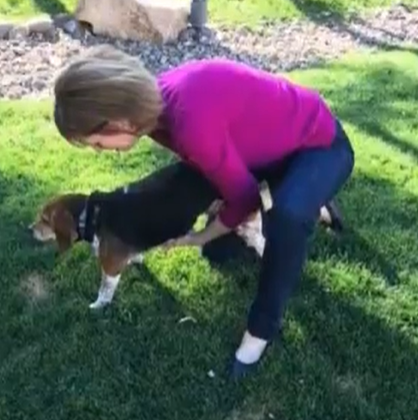
Place your dog in an upright position while supporting the rear limbs.
Feel for the bladder at the midpoint of the lower belly.
Slip one hand for small dogs or one arm for large dogs under the lower belly for support.
Use your free hand to put pressure on the bladder and slowly pull your arm upward.
Put pressure on the bladder until a steady stream of urine flows.
When the stream becomes a dribble. Stop, wait 30 seconds and push again to be sure the bladder is empty.
Watch for a strong ammonia smell. It could mean a urinary tract infection is brewing.
Tips for dogs who are hard to express
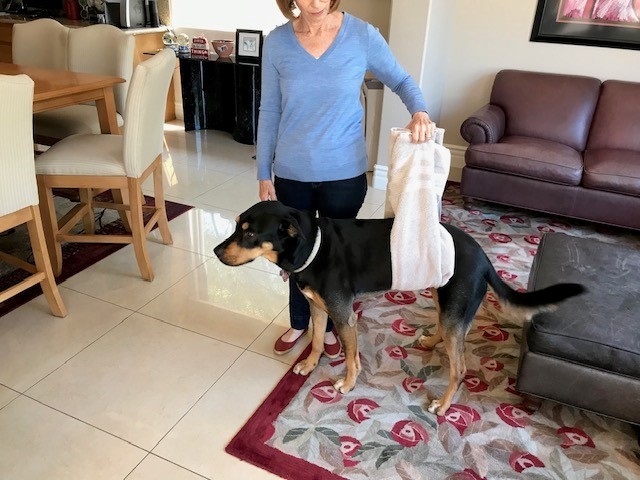
Whether you’re an expert at manually expressing your dog’s bladder or the pet parent of a pup who is difficult to express, it’s good to know that as your dog ages, the technique you use might need tweaking.
Recently a pet mom contacted me about this problem. She and her mother had been expressing their puggle for 13 years, but the mother had developed arthritis in her hands. The pain of squeezing and holding the dog were too much for her. She needed another approach that didn’t require her to use her hands.

My favorite harnesses for disabled dogs.
We came up with two recommendations:
- Put the dog in a support/lifting sling and fit it over the lower belly where the bladder is located. Then pull up on the handles of the sling to put a bit of pressure on the bladder. The gentle pressure on the bladder will cause the dog to urinate. You’ll find a photo of this technique above.
- Place the pup into his dog wheelchair. The lower belly should sit right able the wheelchair saddle. For most dogs, especially those with a full bladder, the gentle pressure of the sling should cause the dog to urinate.
It’s okay to improvise
Some dogs feel secure in a standing position, supported with your arms, and others prefer to lie on their side. No single position is correct as long as it doesn’t endanger your pet’s health or cause anxiety.
Learning how to express your dog’s bladder takes time. Be patient and kind to yourself while you’re learning. Before you know it, you’ll be an expert.
Here’s a video to get you started
Here are some related articles you might enjoy
Elements to Stop Dog Urinary Tract Infections
Why Urine Scald in a Paralyzed Dog Is A Big Problem


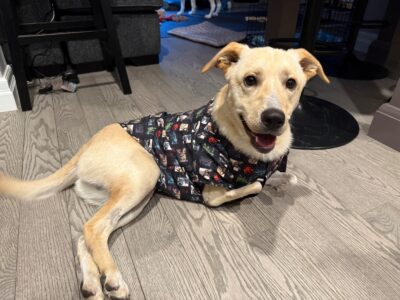
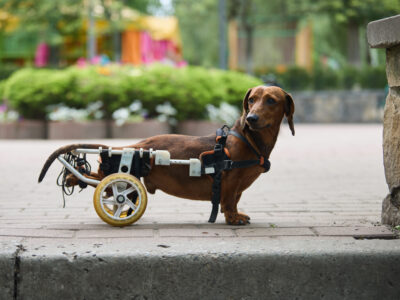
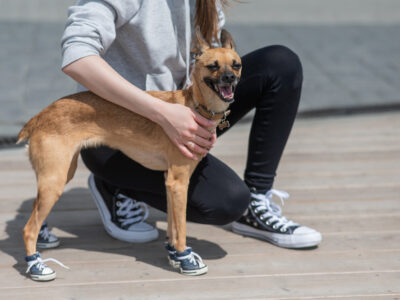

Leave a Reply